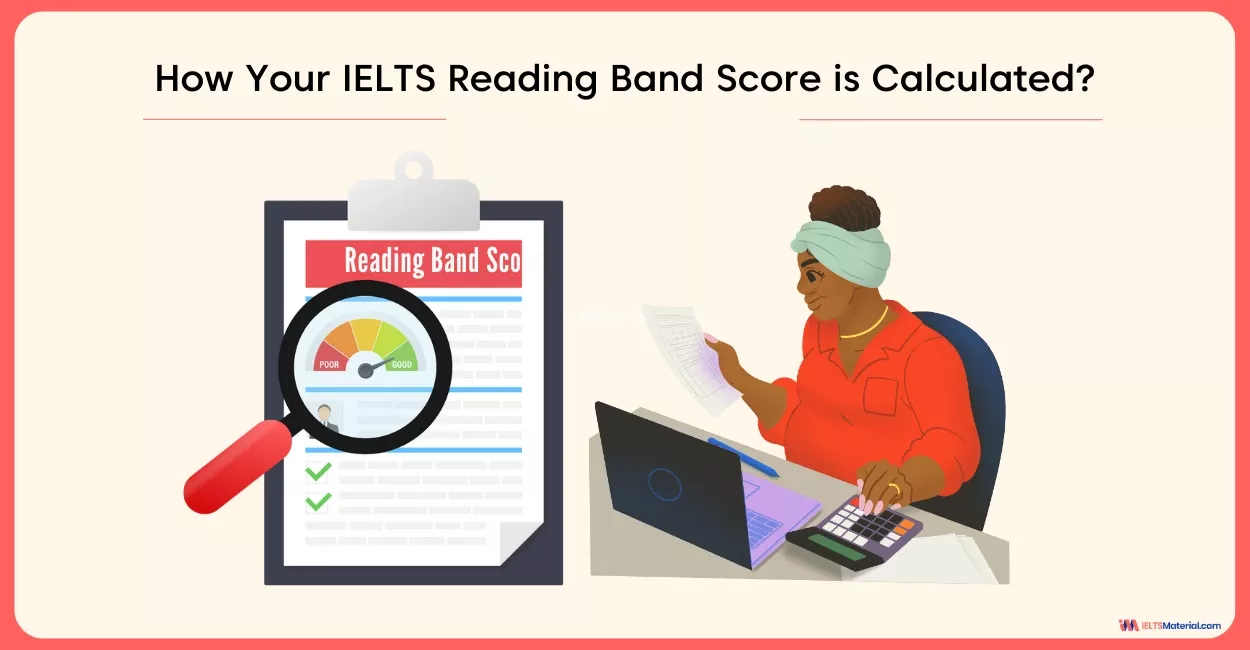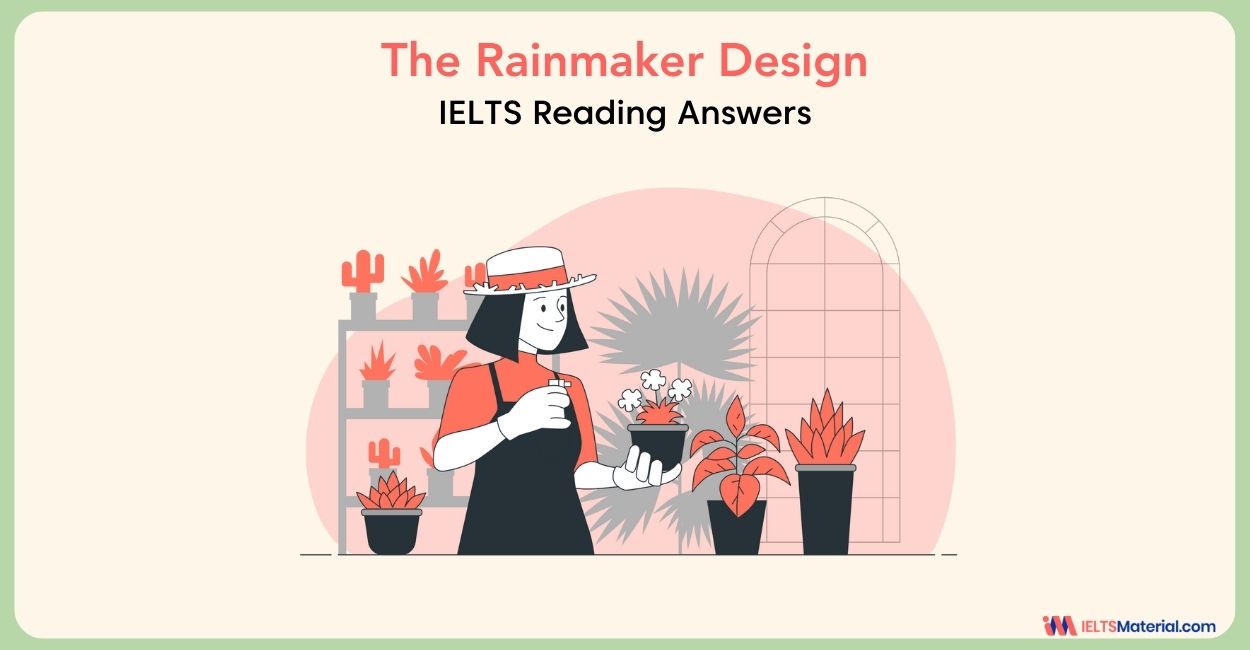The Rainmaker Design IELTS Reading Answers
10 min read
Updated On
-
Copy link
This blog explores detailed answers with answer location and explanation for The Rainmaker Design IELTS Reading passage with vocabulary, strategies, and tips to boost your reading accuracy and score.
Table of Contents

Limited-Time Offer : Access a FREE 10-Day IELTS Study Plan!
Mastering the IELTS Academic Reading section takes strategy and consistent practice. One of the best ways to prepare is by tackling real IELTS Reading test passages like The Rainmaker Design, which has appeared in the official exam. This passage features common IELTS question types such as:
- Yes/No/Not Given
- Diagram Labelling
- Summary Completion
Practising with such IELTS Reading tests not only improves your accuracy but also boosts your confidence and timing. Take the full IELTS reading practice tests below and evaluate your performance using the answer key for The Rainmaker Design.
The Rainmaker Design IELTS Reading Passage
A. Sometimes ideas just pop up out of the blue. Or in Charlie Paton’s case, out of the rain. ‘I was on a bus in Morocco traveling through the desert,’ he remembers. ‘It had been raining and the bus was full of hot, wet people. The windows steamed up and I went to sleep with a towel against the glass. When I woke, the thing was soaking wet. I had to wring it out. And it set me thinking. Why was it so wet?
B. The answer, of course, was condensation. Back home in London, a physicist friend, Philip Davies, explained that the glass, chilled by the rain outside, had cooled the hot humid air inside the bus below its dew point, causing droplets of water to form on the inside of the window. Intrigued, Paton – a lighting engineer by profession – started rigging up his own equipment. ‘I made my own solar stills. It occurred to me that you might be able to produce water in this way in the desert, simply by cooling the air. I wondered whether you could make enough to irrigate fields and grow crops.’
C. Today, a decade on, his dream has taken shape as a giant greenhouse on a desert island off Abu Dhabi in the Persian Gulf – the first commercially viable version of his ‘seawater greenhouse’. Local scientists, working with Paton, are watering the desert and growing vegetables in what is basically a giant dew-making machine that produces freshwater and cool air from sun and seawater. In awarding Paton first prize in a design competition two years ago, Marco Goldschmied, president of the Royal Institute of British Architects, called it ‘a truly original idea which has the potential to impact on the lives of millions of people living in coastal water-starved areas around the world’.
D. The seawater greenhouse as developed by Paton has three main parts. They both air-condition the greenhouse and provide water for irrigation. The front of the greenhouse faces into the prevailing wind so that hot dry air blows in through a front wall. The wall is made of perforated cardboard kept moist by a constant trickle of seawater pumped up from the ocean. The purpose is to cool and moisten the incoming desert air. The cool moist air allows the plants to grow faster. And, crucially, because much less water evaporates from the leaves, the plants need much less moisture to grow than if they were being irrigated in the hot dry desert air outside the greenhouse.
E. The air-conditioning of the interior of the greenhouse is completed by the second feature: the roof. It has two layers: an outer layer of clear polyethylene and an inner coated layer that reflects infrared radiation. This combination ensures that visible light can stream through to the plants, maximizing the rate of plant growth through photosynthesis but at the same time heat from the infrared radiation is trapped in the space between the layers, and kept away from the plants. This helps keep the air around the plants cool.
F. At the back of the greenhouse sits the third element. This is the main water production unit. Here, the air hits a second moist cardboard wall that increases its humidity as it reaches the condenser, which finally collects from the hot humid air the moisture for irrigating the plants. The condenser is a metal surface kept cool by still more seawater. It is the equivalent of the window on Paton’s Moroccan bus. Drops of pure distilled water from on the condenser and flow into a tank for irrigating the crops.
G. The Abu Dhai greenhouse more or less runs itself. Sensors switch everything on when the sun rises and alter flows of air and seawater through the day in response to changes in temperature, humidity, and sunlight. On windless days, fans ensure a constant flow of air through the greenhouse. ‘Once it is turned to the local environment, you don’t need anymore there for it to work,’ says Paton. “We can run the entire operation of one 13-amp plug, and in the future, we could make it entirely independent of the grid, powered from a few solar panels.’
H. Critics point out that construction costs of around $4 a square foot are quite high. By illustration, however, Paton presents that it can cool as efficiently as a 500-kilowatt air conditioner while using less than 3 kilowatts of electricity. Thus the plants need only an eighth of the volume of water used by those grown conventionally. And so the effective cost of the desalinated water in the greenhouse is only a quarter that of water from a standard desalinator, which is good economics. Besides, it really suggests an environmentally-friendly way of providing air conditioning on a scale large enough to cool large greenhouses where crops can be grown despite the high outside temperatures.
The Rainmaker Design IELTS Reading Question
Questions 27-31
- Do the following statements agree with the claims of the writer in Reading Passage 3?
- In boxes 27-31 on your answer sheet, write
- YES if the statement is true
- NO if the statement is false
- NOT GIVEN if the information is not given in the passage
27 The idea just came to Charlie Paton by accident.
28 The bus was well ventilated.
29 After waking up, Paton found his towel was wet.
30 The fan on the bus did not work well.
31 Paton immediately operated his own business in the Persian Gulf after talking with Philip Davies.
Questions 32-36

32.
33.
34.
35.
36.
Questions 37-40
To some extent, the Abu Dhai greenhouse functions automatically. When the day is sunny, the equipment can respond to the changes in several natural elements. When there is no wind, 37______________ help to retain the flow of air. Even in the future, we have an ideal plan to power the greenhouse from 38____________ . However, there are still some critics who argue that 39______________ are not good economics. To justify himself, Paton presents favorable arguments against these critics and suggests that it is an 40____________ approach to provide air conditioning in a large-scale large sense.
Want to improve your IELTS Academic Reading score? Grab Our IELTS Reading Ebook Today!
The Rainmaker Design IELTS Reading Answer Explanation
Let’s now review the answers to the questions from the passage in the reading section, The Rainmaker Design IELTS Reading Answers, and assess your improvement for a high IELTS Reading band score.
27. Answer: YES
Answer location: Paragraph A; Lines 1–2
Ans exp: The passage states, "Sometimes ideas just pop up out of the blue. Or in Charlie Paton’s case, out of the rain," confirming the statement is true.
28. Answer: NO
Answer location: Paragraph A; Lines 3–5
Ans exp: The statement suggests a different context, while the passage says Paton was on a bus in Morocco when the idea formed, making the statement false.
29. Answer: YES
Answer location: Paragraph A; Line 6
Ans exp: The text directly states, "When I woke, the thing was soaking wet," confirming the statement.
30. Answer: NOT GIVEN
Answer location: –
Ans exp: There is no information in the passage to confirm or deny the statement.
31. Answer: NO
Answer location: Paragraph C; Line 1
Ans exp: The statement contradicts the passage, which clarifies the greenhouse is already built and operating, not just a dream.
32. Answer: hot dry air
Answer location: Paragraph D; Line 3
Ans exp: It mentions, "hot dry air blows in through a front wall," matching the correct phrase.
33. Answer: moist
Answer location: Paragraph D; Line 4
Ans exp: The wall is "kept moist by a constant trickle of seawater," clearly providing the answer.
34. Answer: infrared radiation
Answer location: Paragraph E; Line 2
Ans exp: The passage explains how "heat from the infrared radiation is trapped... and kept away from the plants," confirming the term.
35. Answer: pure distilled water
Answer location: Paragraph F; Last line
Ans exp: It states, "Drops of pure distilled water from the condenser flow into a tank," directly matching the answer.
36. Answer: condenser
Answer location: Paragraph F; Lines 4–end
Ans exp: The passage compares the condenser to the steamed-up window, stating it collects distilled water, confirming the answer.
37. Answer: fans
Answer location: Paragraph G; Line 3
Ans exp: "On windless days, fans ensure a constant flow of air through the greenhouse," confirming the correct answer.
38. Answer: solar panels
Answer location: Paragraph G; Last line
Ans exp: It says the setup could become "entirely independent... powered from a few solar panels," validating the answer.
39. Answer: construction costs
Answer location: Paragraph H; Line 1
Ans exp: Critics are cited saying "construction costs... are quite high," which supports the answer.
40. Answer: environmentally-friendly
Answer location: Paragraph H; Last line
Ans exp: It mentions "an environmentally-friendly way of providing air conditioning," which confirms the correct phrase.
Want to boost your IELTS score? Enroll in our expert-led IELTS online classes today!
Tips to Solve the Question Types in The Rainmaker Design IELTS Reading Answers
Let us check out some quick IELTS Exam Preparation Tips for Band Score of 8+ to answer the three types of questions in the Reading Answers.
Yes/No/Not Given
Here are the top tips to ace Yes/ No/ Not Given questions in the IELTS reading:
- Understand the difference: “Yes” = agrees with the passage, “No” = contradicts it, “Not Given” = not enough info to decide.
- Focus on the writer’s opinion: These questions test your ability to detect the author’s views or claims, not just facts.
- Avoid assumptions: If the statement seems true but isn't clearly stated, the answer is “Not Given”.
- Watch for qualifying words: Words like all, always, never, some, often can change the meaning drastically.
- Match meaning, not words: Paraphrasing is common, so compare ideas rather than scanning for exact phrases.
Diagram Completion
Diagram completion questions in the IELTS reading require to complete and label the diagram.
- Study the diagram first: Understand the structure or process before looking at the options or the passage.
- Identify keywords in labels: Use them to locate the correct section of the passage quickly.
- Follow the visual order: The diagram often follows a logical or chronological sequence—trace that path.
- Use synonyms and paraphrasing: The same words may not appear in the text—match meaning, not exact wording.
- Beware of word limits: Instructions may say “NO MORE THAN TWO WORDS”—stay within that limit to avoid errors.
Summary Completion
In the Summary completion of the IELTS Reading test which also similar to the Sentence completion, you will be asked to fill in the blanks in incomplete phrases with the relevant words or numbers.
- Read the summary first: Get the gist before diving into the passage.
- Use context clues: The grammar and logic of the sentence can help you predict the type of word needed (noun, verb, etc.).
- Scan for synonyms: The summary uses different words than the passage, so look for paraphrases.
- Locate the answer zone: Summary answers usually come from a specific paragraph or section—not scattered.
- Follow word limits strictly: If it says “ONE WORD ONLY,” don’t write two or use unnecessary articles or prepositions.
Confused about IELTS prep? Join our exclusive IELTS webinar and clear all your doubts!
Mastering passages like “The Rainmaker Design IELTS Reading Answers” can significantly boost your Reading IELTS band score. Regular practice with real exam-style questions not only improves speed and accuracy but also builds your confidence. Keep exploring different IELTS Reading passages and refine your techniques to ensure success on test day.
Check More IELTS Reading Answers
Also Check:
Practice IELTS Reading based on question types

Start Preparing for IELTS: Get Your 10-Day Study Plan Today!
Recent Articles

Nehasri Ravishenbagam

Haniya Yashfeen

Haniya Yashfeen

Haniya Yashfeen




Post your Comments